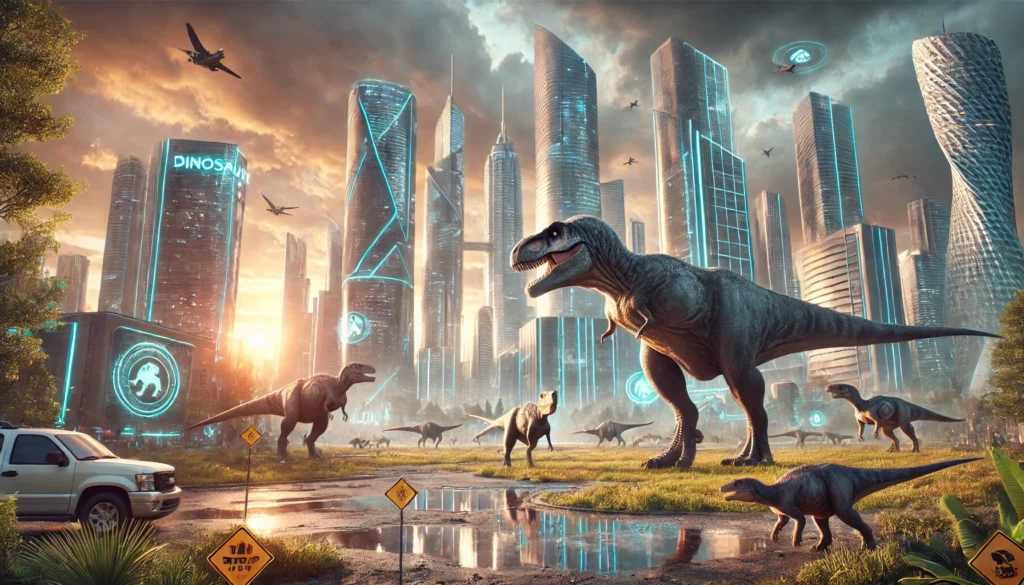Throughout many centuries, dinosaurs have enchanted human beings. The massive prehistoric fossils, along with the blockbuster film Jurassic Park, continue to fascinate people because they dream about living dinosaurs on present-day Earth. Does modern science have the capability to restore dinosaurs to existence? The scientific field of de-extinction that strives to restore extinct animals has recently expanded, yet the challenges of reviving dinosaurs outweigh the benefits. Here, you can explore how can dinosaurs come back to Earth.
Understanding Dinosaur Extinction: A Vanished World
Dinosaurs survived across the Earth for more than 160 million years, although their existence ended suddenly around 66 million years ago. The established scientific principle indicates that dinosaurs vanished because an enormous asteroid struck Earth while volcanic actions and a changing climate simultaneously happened. The disastrous event eliminated almost 75% of Earth’s species, including the non-avian dinosaurs. DNA retrieval proved too tricky for dinosaurs because these creatures vanished from Earth long before the woolly mammoth and other recently extinct species.
The Science of De-Extinction: Can We Bring Dinosaurs Back?
Modern science, through de-extinction, investigates methods for reviving extinct Can dinosaurs come back to Earth species by employing state-of-the-art genetic procedures. Through methods of DNA extraction, cloning, and selective breeding, scientists now successfully revive woolly mammoths and passenger pigeons. However, dinosaurs present unique challenges. DNA availability poses one of the main obstacles that hinders the success of the DNA restoration process. The passage of 66 million years since the dinosaur extinction period has caused all ancestral DNA fragments to break down completely.
Scientists cannot extract viable genetic material from dinosaur fossils since the remnants consist solely of mineralised bones instead of frozen mammoth remains that contain preserved DNA. One main obstacle is the complete lack of present-day organisms with closely related genetics. The scientific team employs elephants as the substitute animals for cloning mammoths. The primary genetic differences between dinosaurian theropods and birds prevent scientists from creating living dinosaurs because of their opposing structures.

Current Scientific Efforts: How Close Are We?
Scientists currently focus on Can dinosaurs come back to Earth, and de-extinction projects involving other animals, even though restoring living dinosaurs remains highly improbable. Scientists use CRISPR gene-editing methods to revive the woolly mammoth and attempt to add specific mammoth characteristics to living Asian elephants. Experts continue their work toward breeding back the dodo bird, which disappeared from the planet during the 1600s.
Palaeontologists are now focusing on modern-day bird research to learn about dinosaur genetic traits. They have uncovered preserved soft tissue elements in select dinosaur fossil discoveries, leading scientists to consider obtaining proteins capable of revealing insights about dinosaur biological processes. Obtaining DNA for cloning purposes has different requirements than retrieving preserved genetic materials.
Alternative Methods to “Bring Back” Dinosaurs
Since direct cloning is not feasible, some scientists have proposed alternative approaches. Can dinosaurs come back to Earth to create dinosaur-like creatures? One of these methods involves reverse-engineering birds. Given that birds are the closest living relatives of dinosaurs, researchers have experimented with modifying chicken embryos to express ancient dinosaur traits.
In 2015, a team of scientists successfully manipulated chicken embryos to grow dinosaur-like snouts instead of beaks. Other experiments have attempted to reintroduce long tails and clawed wings. While these modifications bring scientists closer to understanding dinosaur evolution, they do not result in the revival of an actual dinosaur.
Ethical and Environmental Concerns
Even if science made it possible to understand Can dinosaurs come back to Earth, the question remains—should we? Ethical concerns and ecological implications become significant when scientists attempt to restore extinct species that belong to the millions of years scale. One primary concern is habitat. The Earth undergoes significant changes after the dinosaurs become extinct, while their supporting ecosystems disappear.
Modern environments may become unstable when T. rex or Triceratops species are reintroduced to their natural habitats, as this could damage existing ecological systems. Biological and ethical problems persist regarding the well-being of dinosaurs that would be brought back to life. Would they be kept in captivity? Could they survive in the wild? How would they interact with modern animals and humans? These questions highlight the moral dilemmas associated with de-extinction.
You Might Also Like: How To Remove Scratches From Glasses
The Future of Dinosaurs in Science and Fiction
Dinosaurs will persist indefinitely within the spheres of scientific study and entertainment fields despite the lack of their return to physical existence. Modern technology helps palaeontologists develop precise forms of representation to understand the way extinct creatures behaved, as well as how they appeared and the sounds they made. Scientists study evolution. Can dinosaurs come back to Earth through the genetic makeup of birds because they can replicate dinosaur characteristics? The discovery of new fossils by scientific teams delivers expanded knowledge about dinosaurs’ lifestyles as well as their relationships with their natural habitats.
The fields of virtual reality, augmented reality, and robotics demonstrate how dinosaurs can be recreated without the need for de-extinction methods. The exploration of prehistoric life continues to prevent dinosaurs from fading into oblivion despite the scientific unfeasibility of Jurassic Park in reality. The dinosaurs continue to guide historical research and evolutionary studies even though they remain absent from our current world.
Frequently Asked Questions
Can Dinosaurs Be Brought Back To Life?
No, true de-extinction is not possible due to the complete degradation of dinosaur DNA over millions of years.
Have Scientists Found Dinosaur DNA?
No, fossilised remains contain no viable DNA, making cloning or genetic reconstruction impossible.
Can Birds Be Modified To Become Dinosaurs?
Scientists have experimented with altering bird embryos to express dinosaur-like traits, but this does not create real dinosaurs.
Conclusion
While many wonder whether Can dinosaurs come back to Earth, science proves that true de-extinction is nearly impossible. DNA decay, ethical dilemmas, and ecological risks make reviving dinosaurs highly unlikely. However, scientific advancements in genetics and palaeontology continue to uncover fascinating insights about these prehistoric giants. While real dinosaurs may never roam the Earth again, they will always thrive in research, discovery, and imagination.




[…] You Might Also Like: Can Dinosaurs Come Back to Earth? The Science of De-Extinction […]